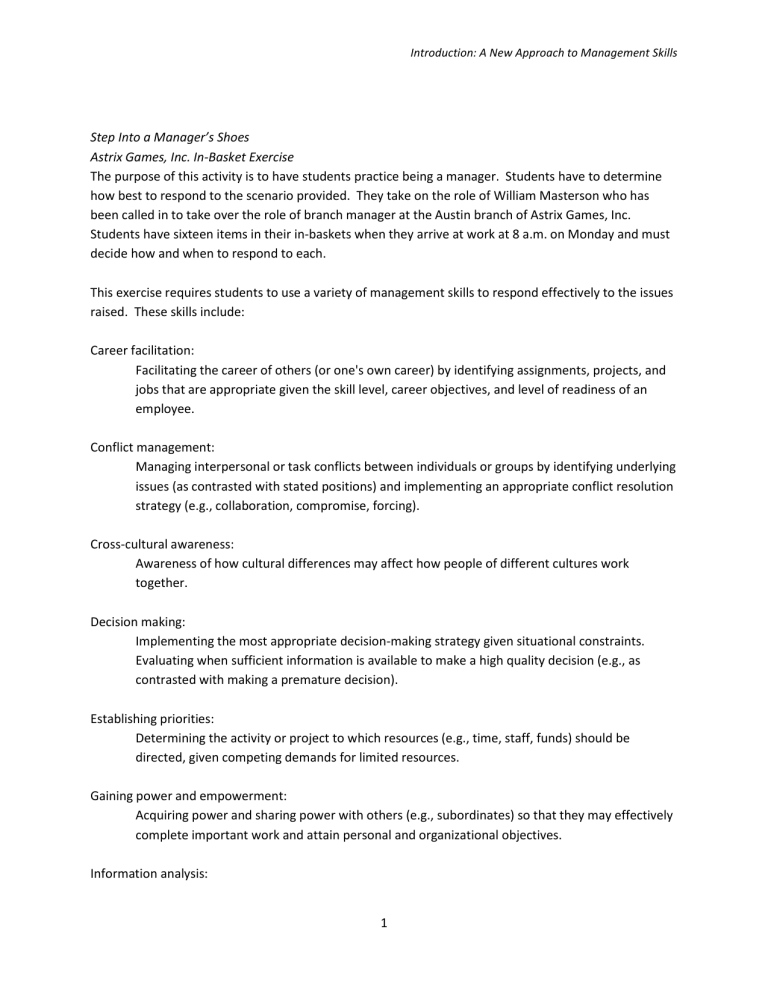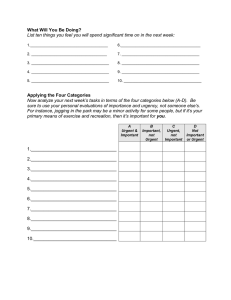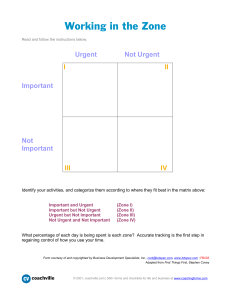
Introduction: A New Approach to Management Skills Step Into a Manager’s Shoes Astrix Games, Inc. In-Basket Exercise The purpose of this activity is to have students practice being a manager. Students have to determine how best to respond to the scenario provided. They take on the role of William Masterson who has been called in to take over the role of branch manager at the Austin branch of Astrix Games, Inc. Students have sixteen items in their in-baskets when they arrive at work at 8 a.m. on Monday and must decide how and when to respond to each. This exercise requires students to use a variety of management skills to respond effectively to the issues raised. These skills include: Career facilitation: Facilitating the career of others (or one's own career) by identifying assignments, projects, and jobs that are appropriate given the skill level, career objectives, and level of readiness of an employee. Conflict management: Managing interpersonal or task conflicts between individuals or groups by identifying underlying issues (as contrasted with stated positions) and implementing an appropriate conflict resolution strategy (e.g., collaboration, compromise, forcing). Cross-cultural awareness: Awareness of how cultural differences may affect how people of different cultures work together. Decision making: Implementing the most appropriate decision-making strategy given situational constraints. Evaluating when sufficient information is available to make a high quality decision (e.g., as contrasted with making a premature decision). Establishing priorities: Determining the activity or project to which resources (e.g., time, staff, funds) should be directed, given competing demands for limited resources. Gaining power and empowerment: Acquiring power and sharing power with others (e.g., subordinates) so that they may effectively complete important work and attain personal and organizational objectives. Information analysis: 1 Introduction: A New Approach to Management Skills Accurately analyzing and interpreting information or data to support decision making and problem solving. Information gathering: Recognizing when additional information is required to enable effective decision making and problem solving. Identifying the type of information that is required and the source(s) from which information can best be acquired. Integrating information: Integrating information from several different items (e.g., in the in-basket exercise) to identify underlying patterns or issues that could not be readily identified by attending only to information presented in a single item. Managing diversity: Effectively managing employees who have different backgrounds (e.g., race, sex, education, age, sexual orientation, marital or family situation) to make optimal use of their unique abilities, interests, and dispositions. Motivating others: Energizing employees to accept, work toward, and remain committed to difficult organizational goals by identifying and removing obstacles to goal achievement and reinforcing successful behavior and outcomes. Problem solving: Effectively using rational and creative problem solving procedures to arrive at optimal (as contrasted with merely satisfactory) solutions. Stress management: Identifying symptoms of stress and burnout in other employees (and oneself), and implementing effective strategies to eliminate, reduce, or cope with stresses. Supportive communication: Using the principles of supportive communication (including listening, reflecting, and probing) to counsel and coach employees. Effectively planning and conducting one-on-one or group meetings. Team leadership: Forming, managing, and coordinating teams to ensure the appropriate blend of technical, interpersonal, and problem-solving skills can be coordinated to efficiently achieve organizational goals. 2 Introduction: A New Approach to Management Skills Responses to each item: 1. E-mail from Federico Gonzales. This item requires a quick response since the event is the next day. As it is an important celebration for a successful product, a muted celebration could still go on, plus as a new manager Masterson could use this occasion to speak to employees and establish relationships. Thus, Masterson should send an e-mail to Gonzales immediately thanking him for forwarding the information and tell him to not cancel the event. Masterson should definitely make some time to attend the event tomorrow afternoon. This is his opportunity to be seen by the entire Austin Branch. He should make sure to allow enough time to network with people. Masterson should arrange to speak publically to attendees to introduce himself, to provide an update about the status of Ricardo Salas, and to outline his priorities for the immediate future. An inexperienced manager might pass up this opportunity, but an experienced person would promptly seize the opportunity to get in front of branch personnel to bring them up to date, to outline priorities for the near future, and to answer questions. 2. E-mail from Melissa Landsome. There are several issues in the in-basket that refer to Sanjay Anand (Items 8, 13 and 14). In light of this, the best approach is to call Anand and set up a meeting with him immediately to discuss these issues. After the meeting you can reply to Landsome to let her know, who if anyone will be able to attend the vote. It is seems unlikely that one or two people could sway an impending immediate legislative vote, so this is not an urgent priority. Sending someone to speak to members of Congress may have a cumulative effect for positive votes in the future if things with Anand get worked out. 3. E-mail message from Vladimir Benejev. While this is marked “Urgent,” it is not as critical as other issues. People often overestimate the criticalness of their own issues. You can provide a quick email stating that Ricardo Salas is unavailable and that you will provide him an answer to the question in 2-3 days. Then forward the e-mail to Amy Chang, Chief Ethics Officer, because the bribe is likely a violation of the ethics standards at the company, but that is something she can determine for you. Once she has responded, you can then let Benejev know what has been decided. 4. Phone message from Brittany Viescu. This issue requires a bit of time. You will have to schedule a meeting with Shinji Yamamoto to find out what is occurring with the release of the product. Researchers often seek perfection beyond what is needed by consumers and you will have to help sort out whether Shinji is delaying this project beyond what is good for the company. Furthermore, since there are multiple issues that you need to discuss with Yamamoto (Item 12), you can probably save time by sending one e-mail related to both issues and scheduling multiple meetings at once. This is not an urgent issue, but still an important one. So you should send Yamamoto an e-mail now but request a meeting within the next 2-3 days. Once you have scheduled the meeting, send Viescu a quick e-mail to stat that you got her message and that you will be meeting with Yamamoto. 3 Introduction: A New Approach to Management Skills 5. E-mail from Farhad Pirmoradi. This is not an urgent issue and as Pirmoradi is the head of the App Group, he is the best person to determine if the App suggested by Michael Townshend is feasible. So e-mail Pirmoradi back and ask that he contact his manager, Yamamoto, head of R&D to discuss the issue. But in light of some of the personal issues described in an earlier email, you should plan to meet personally with these people fairly soon. 6. E-mail from Dr. Marion P. Wanchowski. This item only requires a brief e-mail response stating that Ricardo Salas is unavailable and that you wish you could assist her; you do not have access to his research. Since she needs a quick response, you can send this e-mail immediate and then this item will be off your desk. But do let her know you’d like a copy of her paper and you’d like to be kept in the loop on her research. Do not blow her off. 7. E-mail from Jason Shahinian. This is an important issue that should be addressed. You should e-mail Shahinian to schedule a meeting to discuss the issue and get more details. Furthermore, you should contact Judith Mendez to also schedule a meeting to get her perspective. Neither of these meeting need to happen immediately, but should occur by the end of the week. Once you have more information and see whether Mendez is a problem manager, you can decide how to proceed. The important thing is to hear both sides of this issue since you don’t have any experience with Judith Mendez. Don’t assume Shahinian’s perspective is 100 percent correct. 8. E-mail from Eduardo Smith. This opportunity to serve a non-profit is important but probably not urgent, so a few days delay will not cause a serious problem. Also, this is another issue that involves Sanjay Anand. Thus, you can discuss this item when you meet with Anand about the issue in Items 2 and 14. Also, you could call Hong Cho to find out if he is available to work with the Austin Domestic Violence Housing Options Center. Then you could call or email Eduardo Smith to tell him that you support his efforts and that he can call Amelia Callispell to let her know if there are programmers that can help her. 9. E-mail from Amy Chang. This is a serious situation and a very sensitive issue. You should not talk about this to others because you don’t know who is linked to whom among employees. This will require you to spend some time looking through data and talking with employees without revealing the true nature of what you are looking for. You can send a short e-mail to Chang to acknowledge that you are looking into the issue. You may want to call Chang to find out more details. Then you will need to allocate some time either Monday afternoon or Tuesday morning to investigate this issue. Be careful in your investigations, as you do not want to alert the offenders. 10. E-mail from Tamika Jones. This is an important issue for Tamika but is not as time sensitive as other issues. On the surface this looks like a person who may not be suited to management or who may need some help making the transition. You will want to e-mail Jones back today and ask to set up a time to meet with her to discuss the issue and determine if she truly wants to return to programming or if there are other issues to address. This meeting can occur later in the week. In the meantime, you should send an e-mail to Bonita Mallard to find out if any management training 4 Introduction: A New Approach to Management Skills exists that you could enroll Jones in that may assist her. You may want to check with Shinji Yamamoto to get his take on how Tamika is doing without revealing the reason for your call. Depending on what you learn from Tamika, you may get her together with Shinji to work out a solution to her dissatisfaction with her role. Furthermore, you may want to keep in mind that if Tamika Jones returns to programming, then her position may be open and Sanjay Anand appears to be an individual who is well respected in the organization. He may be ready to take on a supervisor role. 11. E-mail from Shinji Yamamoto. This is important but not urgent. When you send Yamamoto and email regarding Item 4, also request a second meeting to specifically address this issue. This meeting can happen next week, as it is not as urgent. You should ask a lot of questions to get up to speed on how serious this situation is. Also, there is a contradiction between Shinji delaying the DANCE GUITAR project in item 4 and his hurry-up attitude on DANCE GUITAR in this email that you will want to explore. 12. E-mail message from Emily Latella. This is an important and urgent e-mail, but since you cannot contact Salas, he is not available to deny the quote. You are the top manager in Austin and external PR is important to Astrix’s reputation. You can send an e-mail to Latella to explain that Salas is not available and delegate to her the task of contacting the reporter to tell him that Salas cannot comment on the quote at this time. She should provide a positive spin by asserting that Salas would never say that and it is absolutely not true and the reporter should not publish something that is knowingly false. 13. E-mail from Bonita Mallard. This is a critical issue as Sanjay Anand is a valuable employee. You have several issues you want to address with Anand in the items listed above. When you schedule your meeting with Anand, you also want to discuss his job satisfaction and determine if he is unhappy at the company or with the job. Since the information you received was not shared with you by him, you want to be cautious and not directly state that you know he has another offer, rather you want to determine if there is anything you can do to keep him as an employee. 14. E-mail message from Stephen Schwartzman. As this is an e-mail from the CFO. It is important to respond quickly to it, but the issue isn’t urgent. You definitely want to keep this project moving because of possible substantial longer term savings for Astrix. You can probably wait to respond to this e-mail until after you have met with Anand, or you can let Stephen know you got his message and will get back to him soon. In the meantime, e-mail Tamika Jones, programming supervisor, to ask who she would recommend sending to the meeting. Then send an e-mail replying to Schwartzman with the names. 15. E-mail message from Bonita Mallard. It is critical to address this issue in timely fashion, since allowing this behavior to continue sets a negative tone in the organization. Since others have already complained, this issue should be addressed quickly which will let these women know that you are paying attention and are concerned about this issue. You will want to e-mail Wallinger to 5 Introduction: A New Approach to Management Skills set a meeting up. This meeting should occur in the next couple days. Once you have scheduled the meeting. You might also think about who you could telephone to get more information on Wallinger’s behavior. E-mail Mallard a reply to state when you will be meeting with Wallinger. 16. E-mail message from Gadilaihu Cherel. Since Cherel is the CEO his message should get a quick reply. Ask him in the e-mail when he needs the names by. Also, e-mail Tamika Jones, programming supervisor, to ask who she would recommend sending. If you choose to have them perform this in-box activity in class, ask the students to work in pairs or in small groups. Guide their discussion by asking them the questions, such as: What was most challenging about the activity? How did you decide to prioritize the tasks? If you have time, it is fun to discuss each item and gather opinions on the best way to proceed for each one. Also, refer to the Fragmented Multitasking on Speed Dial section of the Introduction during the debriefing. Alternative assignment: Have the students write a short paper on the assignment summarizing how they prioritized the activities and what they learned about managing from the assignment. 6


